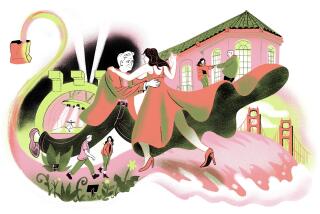The WASP Chronicler : A. R. Gurney looks at the world of quiet wealth and hidden emotions in ‘The Cocktail Hour’ and ‘Love Letters’
NEW YORK — In the lobby of the Promenade Theater, during last year’s run of A. R. Gurney’s “The Cocktail Hour,” a pleasant WASP family proudly boasted to this writer that the playwright grew up across the street from them.
After the curtain calls and applause had died away, one of the younger members of the family was overheard muttering, “How dare he expose us to the whole world like this?”
Pete Gurney laughs when told the story a year later during an interview at his Upper West Side Manhattan apartment. The playwright is relaxed, sunken in his favorite overstuffed chair. He’s heard that reaction before.
“It’s partly because there was a period,” he says, “from after the war, in the ‘50s, ‘60s and most of the ‘70s, when nobody was writing about that, about the upper middle class, except in England, so that when I began to write my plays--I started writing full-length in the ‘70s, and I began hitting closer to home in the ‘80s--people hadn’t seen that (genteel upper middle class WASP) world portrayed, so they think it’s closer to home than it actually is.”
“Everybody thinks that’s their family,” says Jack O’Brien, artistic director of San Diego’s Old Globe and the director of the Los Angeles company of “Cocktail Hour,” which opens Thursday (he also staged it at the Globe, in New York and at the Kennedy Center). “Even the most non-WASP types come up to me and say, ‘No, no, definitely this is my mother and father.’ ” But they don’t have the cocktail hour tradition. “Or that veil of reserve that covers, delicately, what we call honesty. There’s a sort of lens they like to put over everything that puts it all in proper perspective.”
“Cocktail Hour,” with its original and only cast to date, will play at the James E. Doolittle Theatre as part of the Ahmanson season, joining the Pasadena Playhouse’s production of Gurney’s “Love Letters” in a sort of mini-Gurney festival. “Love Letters,” which has been having a preview run in Pasadena (Gurney himself will appear in the last two performances of the Pasadena run today and Monday), and moves to Beverly Hills’ Canon Theatre on Tuesday. The cocktail hour was once a significant part of American life, until the ‘70s.
“It was the ritual of preparing the martini,” Gurney says, “and, as I try to say in the play, after you had the glass in your hand, that was when you settled down and talked about those things that were really important to you. You confronted those issues that meant something, and then you could enjoy your meal.”
Kenneth Frankel directs the Pasadena/Los Angeles production of “Love Letters.” Its particular twist is that it is performed by a new cast of two each week. About Gurney’s exploration of the WASP milieu, he says, “It was a hard row to hoe--to mine something to the depth that he’s been able to do it, something we all thought we knew and weren’t particularly interested in. To deal with emotion in a way that goes much closer to the Puritan ethic is something he handles very well. It’s about not letting your emotions out. That’s unseemly, unmanly, inappropriate and unmannerly. So you find a lot of people taking to drink. Drink is a major factor.”
O’Brien has reasons for feeling close to Gurney’s plays. “That’s my family as well as it is Pete’s.”
“Cocktail Hour” is about a young playwright returning home to ask his parents if he can write a play about them; it sounds autobiographical. “To some degree,” Gurney responds. “The play is not right on the nose. There are elements of it, sure.”
What is certainly autobiographical is the milieu, but Gurney, who’d been writing one-act plays since the middle ‘50s, during the long period when he was teaching at the Massachusetts Institute of Technology, didn’t get around to his main subject until the early ‘70s. And he’s “still mining those fields.”
They’re intricate fields to mine.
“Pete’s work is very subtle,” O’Brien says. “You have to be careful that you listen carefully to what’s going on underneath the play or you miss the mechanism, like a really elegant Swiss watch. You don’t see all that going on under there. One of the criticisms that’s been leveled at this play is that they never really heat up. They never really say what’s on their mind. That’s indigenous to the whole WASP culture, the way we negotiate elegantly cool waters, and keep the pool undisturbed for the next group. As far as Pete’s work is concerned, you can make it all surface if you’re not careful.”
Gurney’s work is “awfully easy to play on the surface,” Frankel agrees, “but on the other hand it has to be played on the surface to a certain extent. That’s the facade. It’s just that you have to have that other life going on in the performances (the thoughts behind the dialogue) so that when it’s called on it’s there. Pete’s very sneaky that way.”
Does Gurney see a pattern in his growth as a playwright? “I see myself moving in a slightly minimalist direction,” he states, shifting only slightly in his easy chair. “I find I’m more and more impatient, trying to narrow it down even more. ‘Love Letters’ is just about as spare as you can get. There’s just the desk. ‘The Cocktail Hour’ has a lovely set, but it’s minimalist in the way it’s done, just four characters, no change of scene at all. It begins with the first cocktail and ends when the cocktail hour is over; it’s continuous time.
“I’m trying to narrow down to the minimalist essentials of stage elements. I also think I’m through, frankly, with writing about WASPs per se. I’ve pretty well explored my own life and I’m through with that.
“But I think you have to write about what you know. I have two general areas where I feel at home: A somewhat middle-Western world, and New York City. I’m also at home in the academic world. I know that pretty well.”
But has Gurney really said everything he has to say about WASPs? “He has and he hasn’t,” O’Brien says. “He plainly has more to say than he’s said. Pete is Pete, and he has a unique spin to put on that fable, and I think it’s one that we need to listen to, because he writes with great passion about those people. And great objectivity at the same time. And that’s a very rare blend.”
And Frankel echoes the feeling. “I hope he keeps knockin’ around where he’s been knockin’ around. He keeps finding things about these people. It’s an area of our society, and its emotional life hasn’t really been brought to the stage. So it’s nice that he’s doing it.”
O’Brien says, “Pete’s a classicist. In all his work, no matter how aberrant it may pretend to be, it’s informed by an extraordinary classical imagination, a man who has read, who has absorbed, synthesized and who has inherently, because of his WASP background, enormous respect in his work. He respects his characters, he respects his audience, he respects their intelligence, he respects the tradition that produced those plays he’s doing. So when he breaks that tradition, it’s never broken with a kind of desultory anger, it’s broken with a wonderful kind of elegance. It’s wonderful to see substantial, experienced writers reaching out in this way.”
“On the surface,” Gurney admits, “ ‘Cocktail Hour’ is an old-fashioned, ostensibly linear play. But I would argue, if I were putting on my professor’s hat, that it’s a post-modern play, because it’s constantly poking holes in its own form. I’m poking fun at the comedy of manners, poking fun at the limitations of the form. I don’t think I’ve ever written a play where I haven’t done that. I cannot pretend, as Henrik Ibsen did, that when the curtain goes up we’re all looking through the fourth wall. I can’t do that. The presentation is a result of intratheatrical reference, calling attention to the ancient nature of the form.”
The two lovers who write (and read) “Love Letters,” grow during the production from age 7 their middle 50s, and they have a strong attraction for Ken Frankel. “It’s almost accidentally one of Pete’s best plays. He covers a much wider emotional range than he generally allows himself, and can do it because of the 50-year span.”
The writing of letters often allows the writer more honesty, and that seems to be true of at least one of the characters in “Love Letters.”
“One of them,” Frankel says, “prides himself on being a kind of counter-revolutionary to the WASP movement. The openness is very hard applied and very hard earned. It is not something they do very easily, which is one of the major events of ‘Love Letters,’ the breaking through.”
With a new cast each week (Christine Lahti and Treat Williams will launch the show at the Canon), “Love Letters” holds the same fascination for its author.
“I saw it in Boston with Julie Harris and Richard Kiley, in their 60s, and then Matthew Broderick and Helen Hunt, in their 20s. That’s a 40-year difference. It’s very moving watching the young people do it. It’s a mistake to think that it’s an arbitrary thing where people are just sitting and reading. It’s about lovers who communicate through their letters, which they read with a kind of urgency.”
A. R. Gurney has been described as an advocate of the “well-made play.” And he is. But he’s also an experimenter, a seeker after new forms and new uses for the theatrical medium.
Like a nova, Gurney’s plays continue to explode, or would it be better to say implode ?
“Theatre is so limited,” Gurney says, “in a world that has more fluid ways of telling a story: the movies, television. . . . I’m constantly trying to find ways where I can be more expansive and still stay within the limits of the stage.”
Gurney knows the territory.
More to Read
The biggest entertainment stories
Get our big stories about Hollywood, film, television, music, arts, culture and more right in your inbox as soon as they publish.
You may occasionally receive promotional content from the Los Angeles Times.










